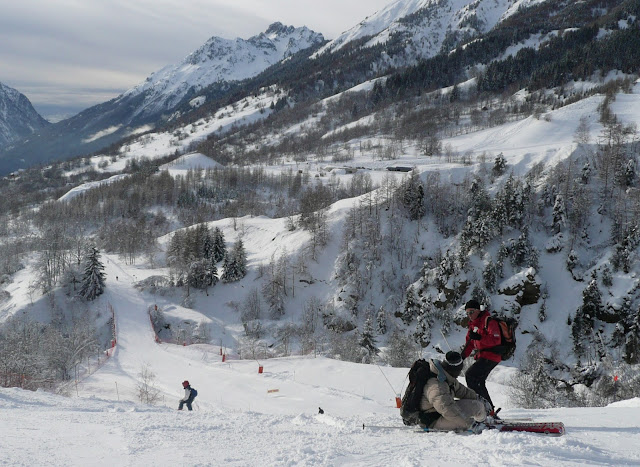Driving between the Signaraux and Festinière I braked on a small curve. The rest is a blur - we are watching a film sequence, it's happening to someone else. No, we are in it, this is us spinning 180 degrees and then sliding off the road. How many times have I seen this kind of accident on mountain roads. Now I know how it happens. And why having only two snow tyres is a such a false economy.
There were two ways for passers-by to react. Either "Are you all right?" (we were) or "How did it happen?" - from just one grinning fellow. Thankfully, the former - concern for our well-being - dominated all but one of our exchanges with the friendliest, most concerned and kind people imaginable. First the post-woman, almost as shocked as we were as we surveyed the aftermath. She took us back up to Signaraux village and we used a villager's phone to summon help. This woman pressed cups of tea, chocolates, biscuits... all very welcome. But unfortunately had to leave shortly afterwards, at which point we had to brave minus 6 degrees on the edge of the road.
And so began an unparalleled saga of "road rescue". For a further two hours we paced up and down to keep warm, distracting ourselves by watching coal tits feeding on grease balls hanging, bizarrely, from surrounding trees (en pleine nature - why? how?), me giving Cinda French lessons. Our instinct had of course been to get a ride home, but the rescue organisation had insisted it was obligatory to remain with the vehicule. Eventually I flagged down a motorist to use her phone. And discovered that Europ Assistance had forgotten all about us. At the same time I broke the news to Juan, just arrived home from CH. Forty minutes later Juan's arrival on the scene coincided with that of the rescue service man, in a small transporter. With his dog but without the equipment needed to haul the car up the slope.
While Cinda and I warmed up in Juan's car the rescue man stared at the Mégane, shaking his head, nonplussed. Eventually Juan had to put it to him that the only solution was to rdv the following morning with proper gear. Dear Juan then made the early start. And found no one there. Because the lorry had been delayed putting on chains to get up the slope. Once by the car a further 45 minutes were needed to try pulling from different angles - the transporter itself in danger of slipping off the road. And ça y est, the Mégane is now in the Gières Renault garage awaiting the loss adjuster's call on whether it is reparable or not.
The rest of the weekend was of course overshadowed by this event. But we nevertheless kept our plan of spending a night in the gîte at St Disdier, Dévoluy. We didin't see the area in the best conditions (snow, sleet, rain) but it gave us a taste of the area in winter. A refaire at a more auspicious moment.





























































